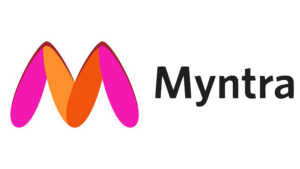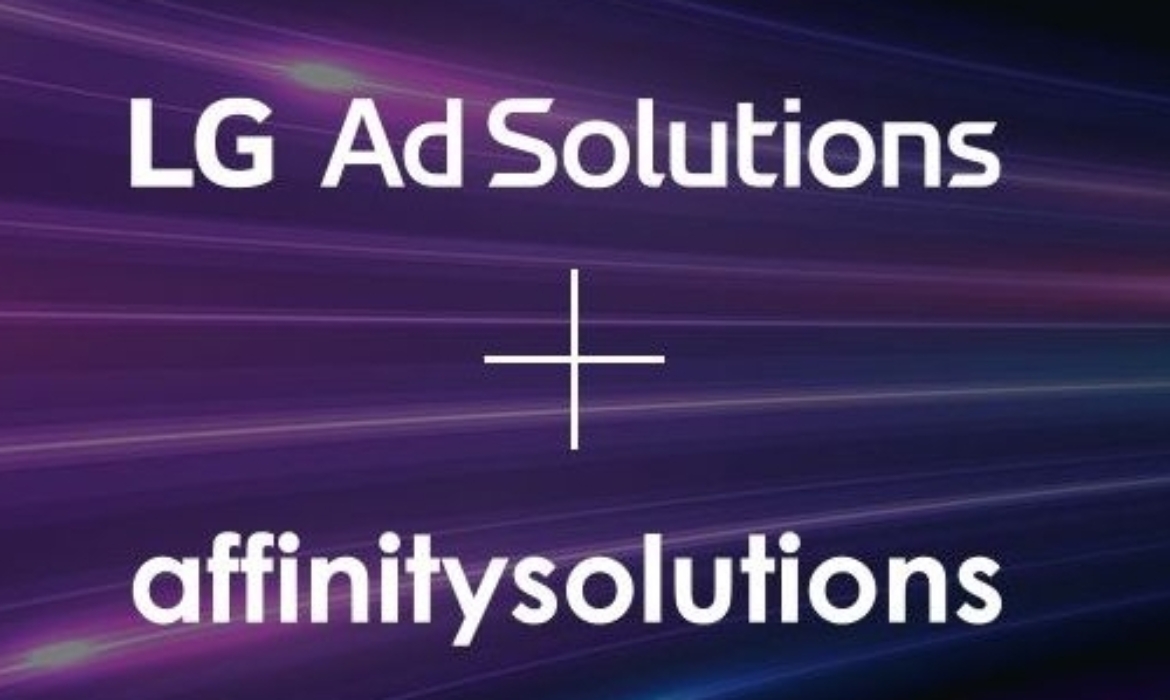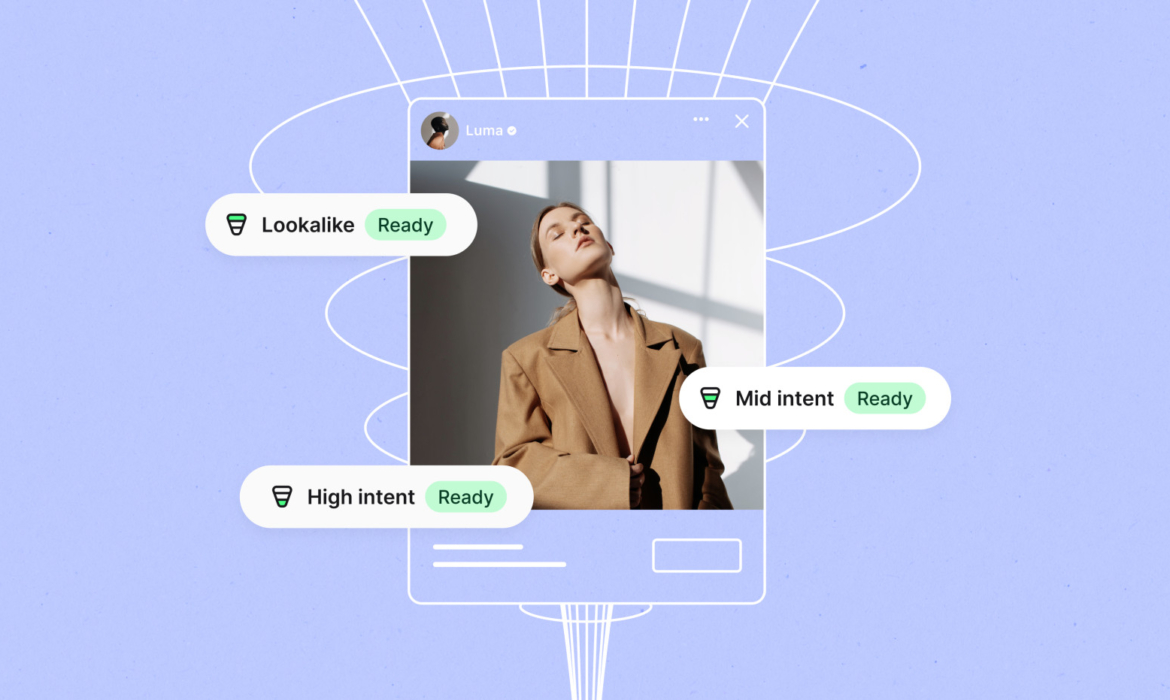The Role of AI in Personalized Advertising
Photo by Mohamed Nohassi on Unsplash
Brands utilize customer data to target behavior, interests, and more to strategize their advertising efforts effectively. Creativity and customizing advertising efforts to cater to your audience is a tried-and-true method to attract prospects, and personalization helps foster the connections to convert them into loyal customers.
One of the biggest challenges businesses face is combining the creativity and analysis of data to work together. But further advances in digital security are putting a stop to behavioral targeting. Artificial intelligence is making great strides in scaling both strategy and creativity to help expand businesses to reach wider audiences.
Narrowing down on your target customer as much as possible is the best way to predict habits and cater more personally toward them with your advertising. Here’s a look into the role of AI when it comes to personalized advertising.
Why Utilize Artificial Intelligence in Your Business?
There are advantages for your business to begin using AI in marketing. One of AI’s most significant and helpful jobs is processing and analyzing large and complex amounts of data quickly.
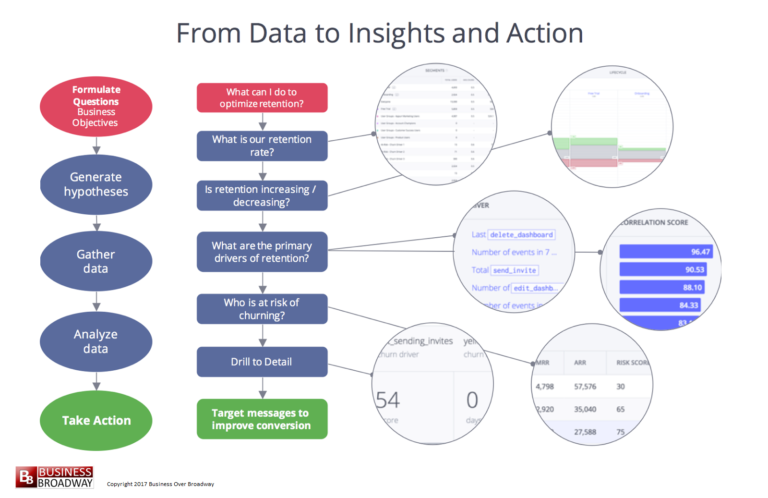
Image credit- Business Broadway
Customer Analysis
With data analysis, algorithms can make predictions by identifying customer interests, needs, and behavior patterns. Your advertising can develop a more personalized experience for each client with this information. With personalized messaging and targeted campaigns, social media platforms can display exceptional product recommendations.
Optimization
AI also helps optimize your advertising in real time; the analysis of data allows your marketing teams to make adjustments more immediately, improving their impact. If you can see that the campaign or advertising efforts aren’t working well, your business will see this with AI and be able to fix it quickly.
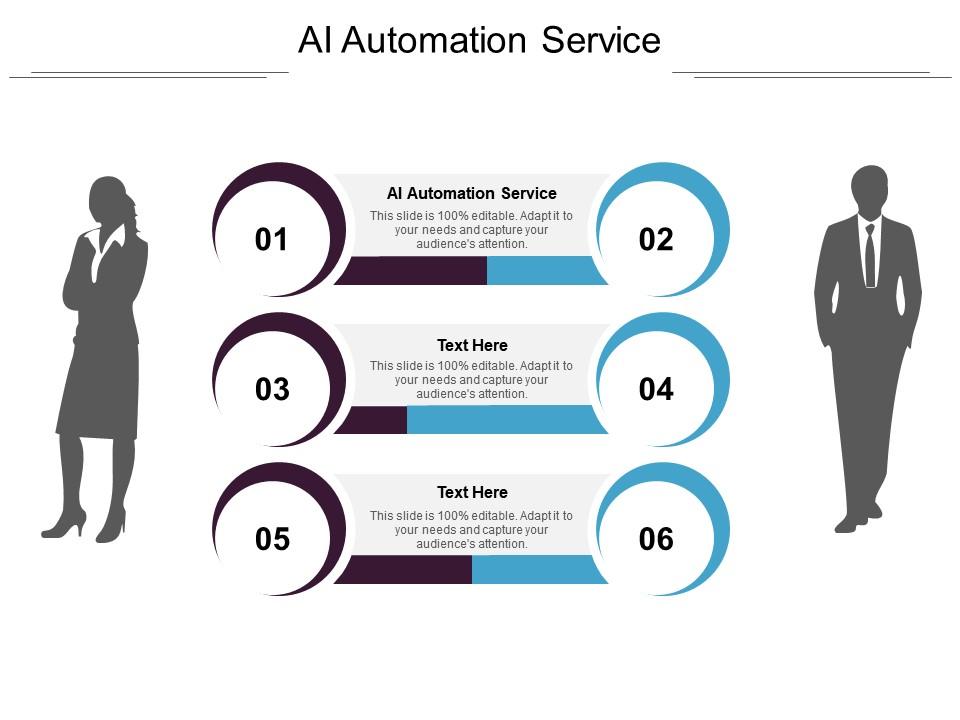
Image credit- Slide Team
Automation
Another excellent benefit that AI brings to your marketing is automation. Tools and resources with technological advances provide marketing teams the power to create personalized experiences for their customers, individually and simultaneously. The best part is your teams don’t have to do anything; just set the parameters, and AI can take over, even in areas like push notifications where timely and relevant communication can be automated to enhance customer engagement and retention.
Customer Loyalty
One of the other essential aspects of your business is to establish trust for customers to return and increase retention. With AI, the possibilities are endless to improve efficiency and increase buyer satisfaction, which nurtures that connection and ensures a return. AI continuously improves, ensuring you’ll have even more ways to create individual relationships.
How Artificial Intelligence Works
One of the primary functions that AI can do is its analysis of customer behavior and collecting this information to implement a more personalized experience. AI looks at multiple aspects of the customer experience, including the following:
- Purchase history
- Demographics
- Websites visited
- Search behavior
- Social media activity
AI works to identify patterns and trends in customer activity. It can pull data from various sources, including Google Ads Data Manager, to create a detailed profile of prospective buyers. The demographic information allows your business to pinpoint the desired gender, age, location, and interests to give your business a more targeted experience for those customers.
The predictive ability of AI is also quite remarkable. It looks at prior activity and information to make accurate predictions about what products or services peak interest and if a customer is more likely to buy. It also provides forecasts on the social media channels that are more likely to be utilized.
Your advertising efforts can be more customized to fit your client’s needs based on the patterns and behavior that AI shows. It can help to utilize some outside media services or expert marketing agencies who know the ins and outs of AI for your business. Tailoring your promotions and campaigns to suit customer preferences with convenient tools, including cookieless advertising, can drive sales and profitability in record time.
Examples of Artificial Intelligence in Advertising
Numerous examples of businesses that use AI for more personalized advertising are visible today. Some successful marketing campaigns have proven to improve customer experiences and increase engagement.

Image credit- Yahoo
Product recommendations on Amazon is an AI algorithm that looks at customer behavior, product search, and purchase history to recommend products more relevant to a customer’s interests effectively and wants. It has resulted in a significant boost in sales to catapult the company as one of the largest e-commerce platforms in the world.

Image credit- Yahoo
Sephora
Sephora has incorporated AI technology in the form of a “virtual try-on,” where customers can find a more tailored product in makeup products. Based on factors like skin tone, skin problems, or particular types have allowed clients to find a more satisfactory product and have improved the reputation of Sephora as a leading beauty retailer.

Image credit- Yahoo
Netflix
Even the streaming video and TV show memberships we own implement AI to help you decide on the ever-looming question of “What to watch?” AI algorithms work to analyze viewing habits and make recommendations for what interests its watchers. It has helped to increase engagement and solidified Netflix’s stance as one of the most popular streaming platforms.
The Future of AI in Personalized Advertising
One of the biggest concerns with using AI for your business stems from privacy since it needs massive customer data to function. Prospective clients may be uncomfortable with providing more personal information.
However, the use of AI in marketing continues to grow and advance, so it’s necessary for your business to ensure that you use it responsibly. Be transparent to your customers and provide options for customers to opt out if necessary. Educating them about how you use your AI responsibly and ethically can also be beneficial.
As AI continues to evolve and grow, you can clearly expect to see more sophisticated and tailored advertising campaigns and new integrations that are effective at ad targeting and drawing in an audience. AI can be integrated into other technologies to create a more engaging experience. At the same time, your business can better understand its ideal customer and improve upon advertising and marketing efforts.
Data and creativity can be combined, creating a balance for businesses to identify and assist individual needs while collecting and securing customer data. These connections through a more personalized advertising experience work across an array of industries and can allow your business to develop and implement more effective advertising campaigns that generate a solid impact while building customer loyalty.

Ron Clark
Marketing | Digital | AI | Social Media | PR | Creative Writer
Ron Clark is an MBA graduate with a specialization in marketing, hailing from the vibrant city of New Orleans, Louisiana. With a keen interest in the ever-evolving field of digital marketing, Ron has dedicated his career to becoming an experienced specialist in social media and digital PR. He’s set his sights on AI, marketing, aiming to write articles that distill his expertise into valuable and informative pieces.
How Ad Ops is Revolutionizing the Indian Advertising Landscape
Welcome to the world of ad operations, where advertising and optimization meet chaos and order, respectively. Ad operations are the foundation of the monetization strategy in the realm of digital marketing. Its function is basic. Make sure the publishers serve the right advertising at the right times. The management and optimization of digital advertising initiatives fall under this category. Ad operations have changed significantly over time. According to a 2022 forecast, revenue for ad media owners will increase by around 6% globally to a record-breaking $865 billion in 2023. As the decade progresses, it is predicted that the annual sum will rise even higher, hitting one trillion dollars by 2026.
Ad Ops is a crucial part of any publisher’s system. It is in charge of overseeing internet sales of digital advertisements and is the most profitable cash cow. In essence, it is a crucial element of ad tech. But what precisely are Ad Ops?
An Introduction to Ad Operations
Ad Ops, often referred to as Digital Ad Operations, is the term used to describe the systems and procedures that enable the management and delivery of digital advertisements. The term refers to any method used by a marketing team to manage, carry out, or improve advertising campaigns. Although there are more than a billion websites, it would be extremely expensive for advertisers to have their adverts seen by everyone around the globe. Instead, companies can attempt to target their ads at individuals who most closely match their existing customers using digital advertising markets. Here’s where ad ops come in.
They are in charge of placing the ads based on the likely audience, time zones, places, and regions. It will generate income in return through advertising initiatives. Ad operations technology links advertisers looking to buy ad space with websites that offer ad space for sale. Despite the fact that the majority of digital ad spaces are sold programmatically and without human intervention, ad operations play a significant role in setting up and overseeing these procedures.
Key Components
Ad operations is the fusion of many technological methods, tools, and stakeholders. The main categories in which the key elements of ad operations fall are:
- Ad trafficking
- Creating and managing ads
- Delivering and targeting ads
Ad Trafficking
Ad Trafficking means setting up and implementing an advertisement campaign so it runs in line with its goals.
- Scheduling – One of the crucial tasks for Ad Ops is to correctly decide and operate pre-fixed schedules for launching and running ads considering the timing of an ad is a key.
- Optimization – One of the most important benefits of digital advertising is the ability to get precise, real-time data on consumer behavior and advertising engagement.
Creating and Managing Ads
Involves choosing ad formats, developing ads, and managing marketing campaigns. To guarantee that ads are properly created and handled, ad ops specialists collaborate closely with advertisers and publishers.
Delivering and targeting ads
Professionals in ad operations employ a variety of targeting strategies, including behavioral and demographic targeting.
- Ad Performance Analytics – To optimize ad campaigns and boost performance, Ad Ops specialists track and analyze data on ad performance.
- Privacy and Ad Compliance – Ad Ops experts must make sure that ads are delivered in a way that respects user privacy and adheres to applicable laws.’
Read More: 10 Game-Changing AI Tools for Digital Marketing in 2023
Advertising Landscape in India
With cutting-edge digital technology becoming more popular than ever in the market, the Indian advertising sector is set to reach new heights. Due to the pandemic, the advertising industry has been struggling to survive the past two years. However, indications show that the Indian advertising sector has been progressively recovering. The market size was INR 743 billion in 2022, and by 2028, it is anticipated to be INR 1,412.5 billion. It has a growth rate of 11%. The Indian advertising industry is expanding at an unprecedented rate, and digital advertising is flourishing. In an effort to reach the target demographic, brands and advertisers are using agile strategies to use digital advertising.
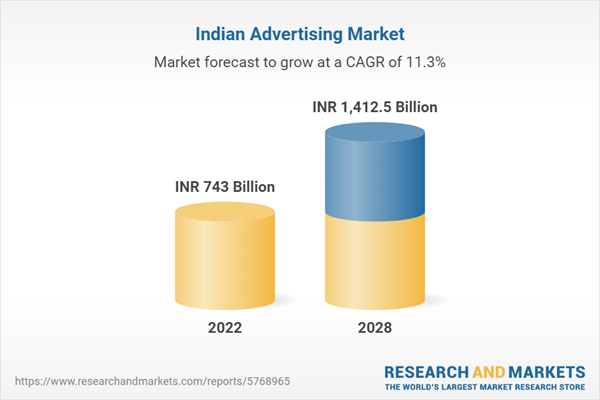
Image credit- Research and Markets
With every second that goes by, the Indian advertising scene continues to grow. Advertising experts adopted a 360-degree strategy as technology improved to include existing and upcoming digital media. Advertising in India, a now-vast industry, is set on being the second-fastest growing advertising market in Asia. It is now more data-driven, with thorough client journeys, mass-customized messages, and attractive deals.
Benefits and Drawbacks of the Ad Ops in the Advertising Landscape

Read More: Cracking the CRED Code: A Deep Dive into its Advertising Mastery
Case Study for Brands Who Leveraged Ad Ops
In India, Zomato is a well-known B2P app for food delivery. Zomato’s excellent marketing campaign has been one of the primary causes of this enormous increase in revenue. It has made it a priority to connect with its target market consistently. Zomato grew when internet marketing became mainstream in India. For instance, appealing ad words on billboards and SMS messages to the target population showed a firm belief in their advertising skills.
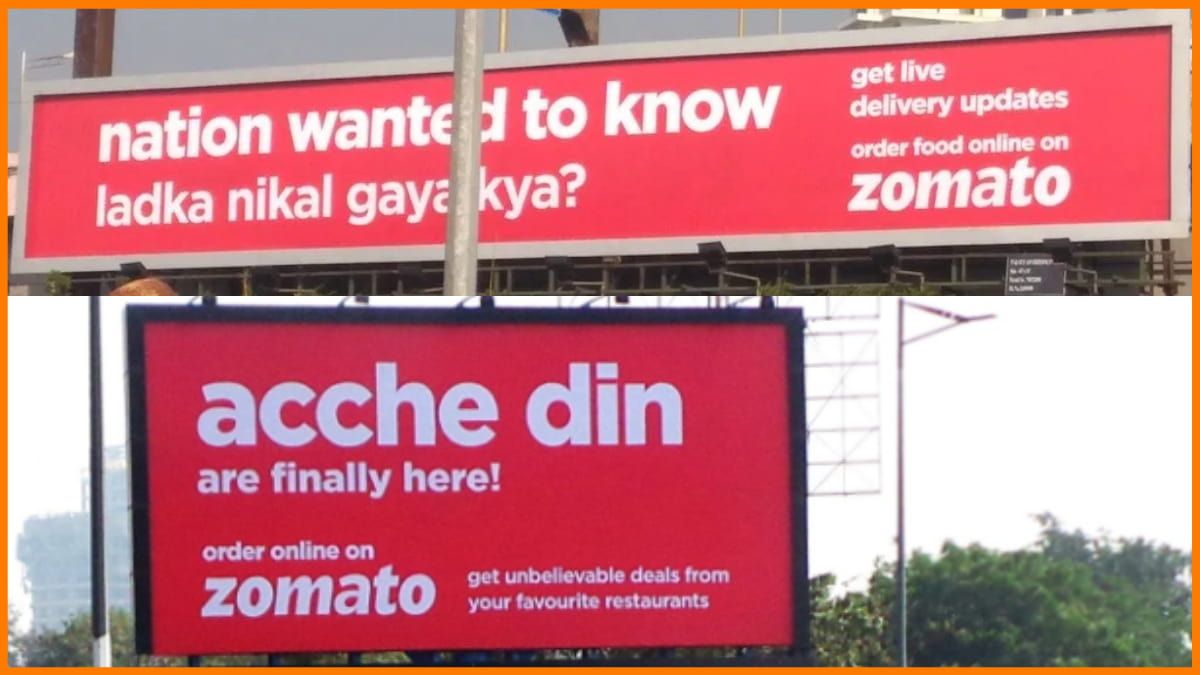
Image credit- Startup Talky
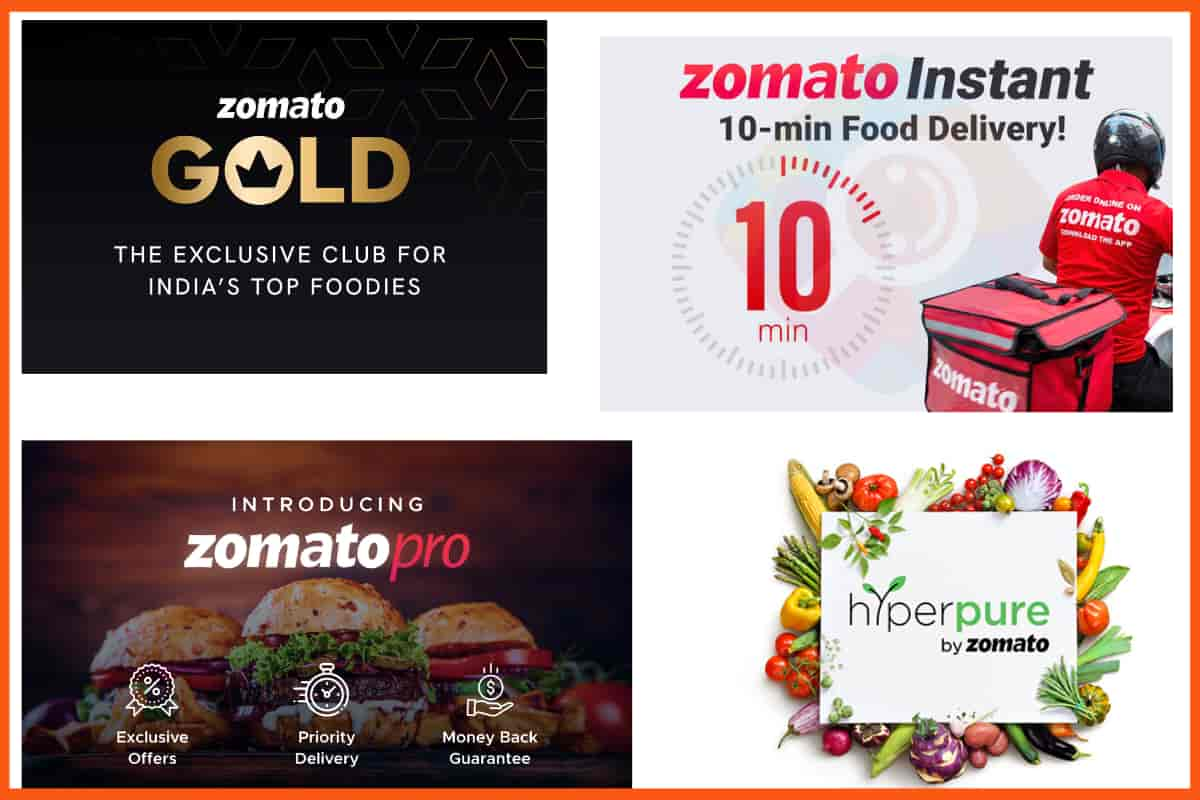
Image credit- Startup Talky
Here are some ways that Zomato’s marketing and ad operations techniques contributed to the app’s success.
- Wide-range and Powerful Outreach
- Email Tactics
- Using Social Media
- SEO Efficiency
Wide-range and Powerful Outreach
Zomato used a variety of outreach strategies in its marketing initiatives. It involves paid advertisements, email and SMS lists, and social media strategy. They studied consumer traits, ordering trends, and peak ordering hours to tailor ads for Zomato’s user base.
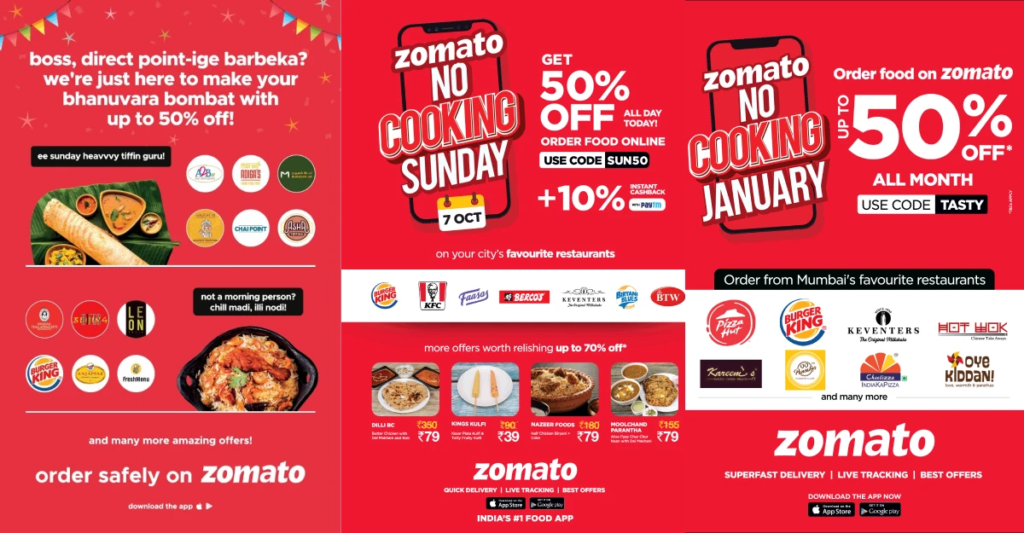
Image credit- The Business Rule
Email Tactics
Zomato targeted a potential niche by curating its emails to implement marketing strategies centered on the binge-watching culture that goes hand in hand with food.
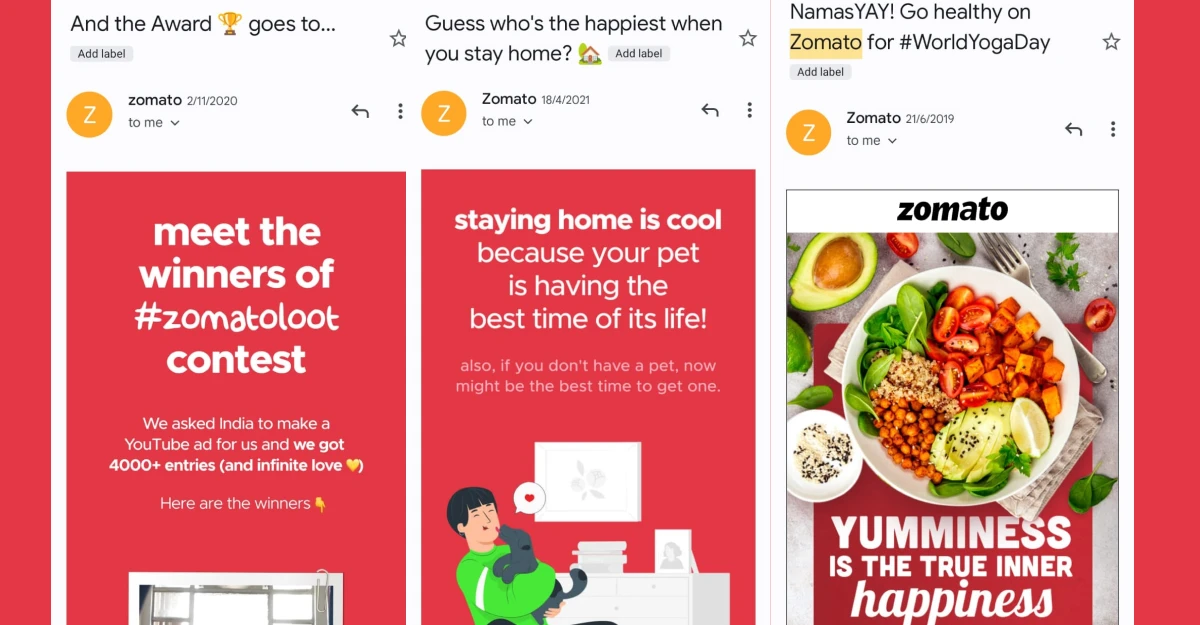
Image credit-The Business Rule
Using Social Media
Zomato depicts itself on social media with postings that are engaging on an emotional level. They interact in regional languages and make humorous memes to participate in meme

Image credit- Social Samosa via Facebook
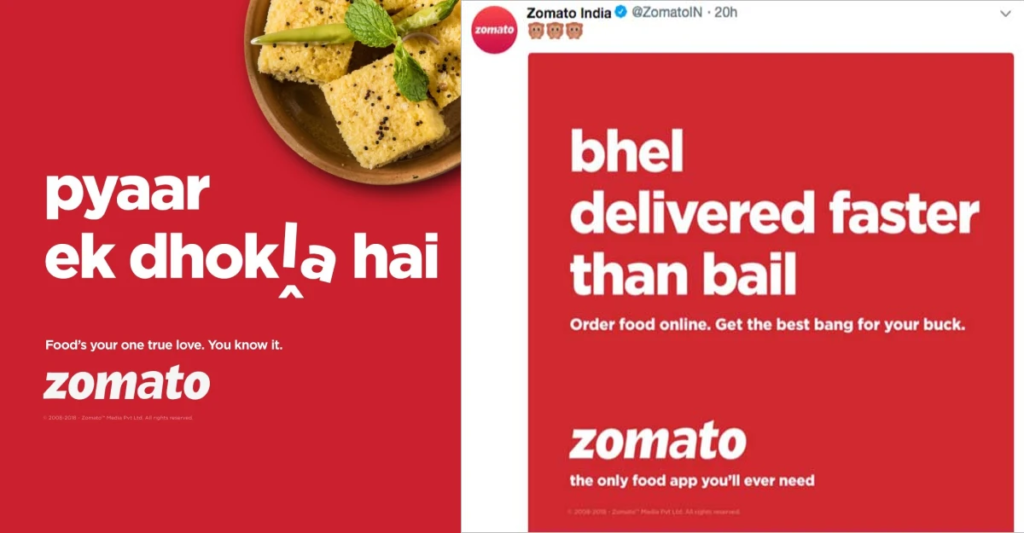
Image credit- The Business Rule
SEO Efficiency
Zomato has produced extremely keyword-dense material that has drawn more than 67 lakh internet visitors.
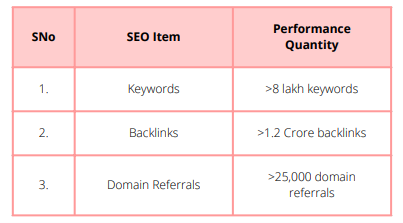
Image credit- iim skills
Zomato has a lot of influence because of its unique strategy of putting novel concepts into action on various fronts. It has always been a top priority for them to pay heed to customer comments and answer as soon as feasible.
Read More: An Innovative Triumph: Burger King x Stevenage FC Case Study
Myntra, a top-tier Indian online apparel retailer, boasts a remarkable “rags-to-riches” journey. Renowned for quality products and stellar customer service, its marketing plan revolves around key pillars for success.
- Content Marketing
- Social Media Marketing
- SEO Efficiency
- Paid Advertising
Content Marketing
Myntra has a popular blog that discusses a wide range of fashion, lifestyle, and trend-related topics. This makes the site one of the most well-liked fashion blogs in India. It leverages content marketing to establish connections with other brands and influencers.

Image credit- Myntra
Social media marketing
Myntra keeps a strong social media presence to ensure its target audience is always aware of the latest content. It routinely undertakes social media campaigns that support the development of the brand’s feeling of community. Additionally, it assists in providing a supply of user-generated material for advertising needs.

Image credit- Indian Retailer
SEO Efficiency
Myntra makes use of SEO to make sure that its website ranks as highly as possible for the right keywords. To do this, they incorporate relevant keywords and phrases into the website text.
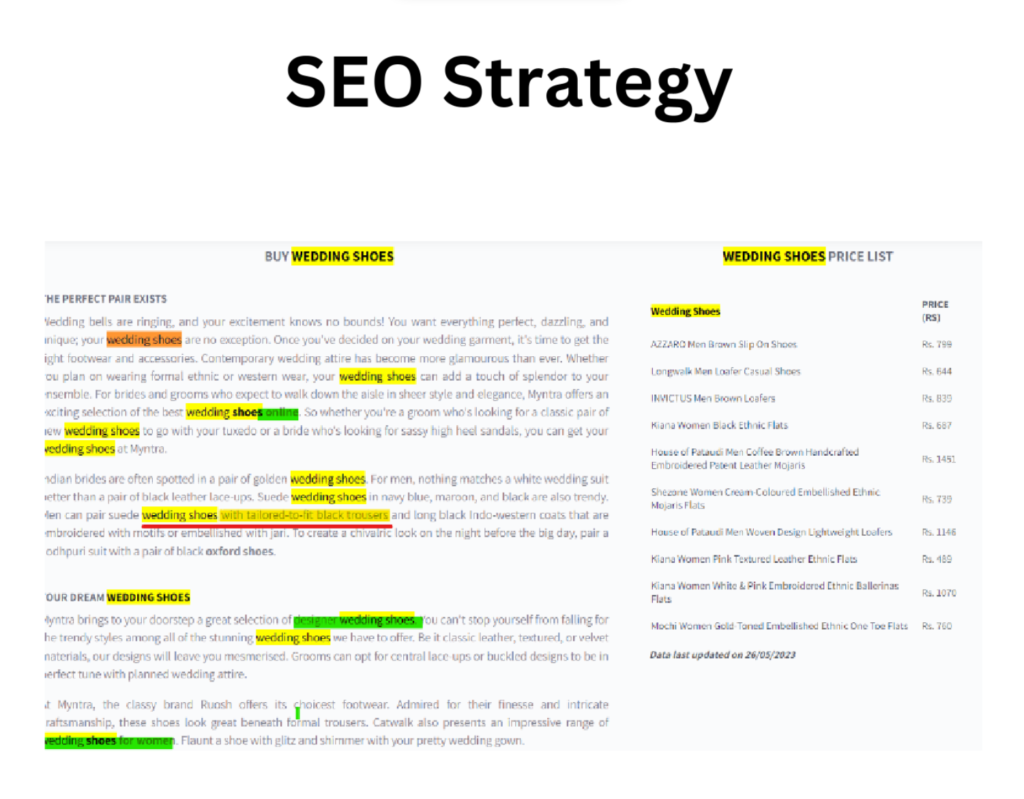
Image credit- Madhu Sudanan via LinkedIn
Paid Advertising
Myntra promotes its website and goods through paid advertising. They employ a variety of strategies, such as display, retargeting, and pay-per-click (PPC) advertising. These techniques enable Myntra to efficiently promote its brand to a large audience.
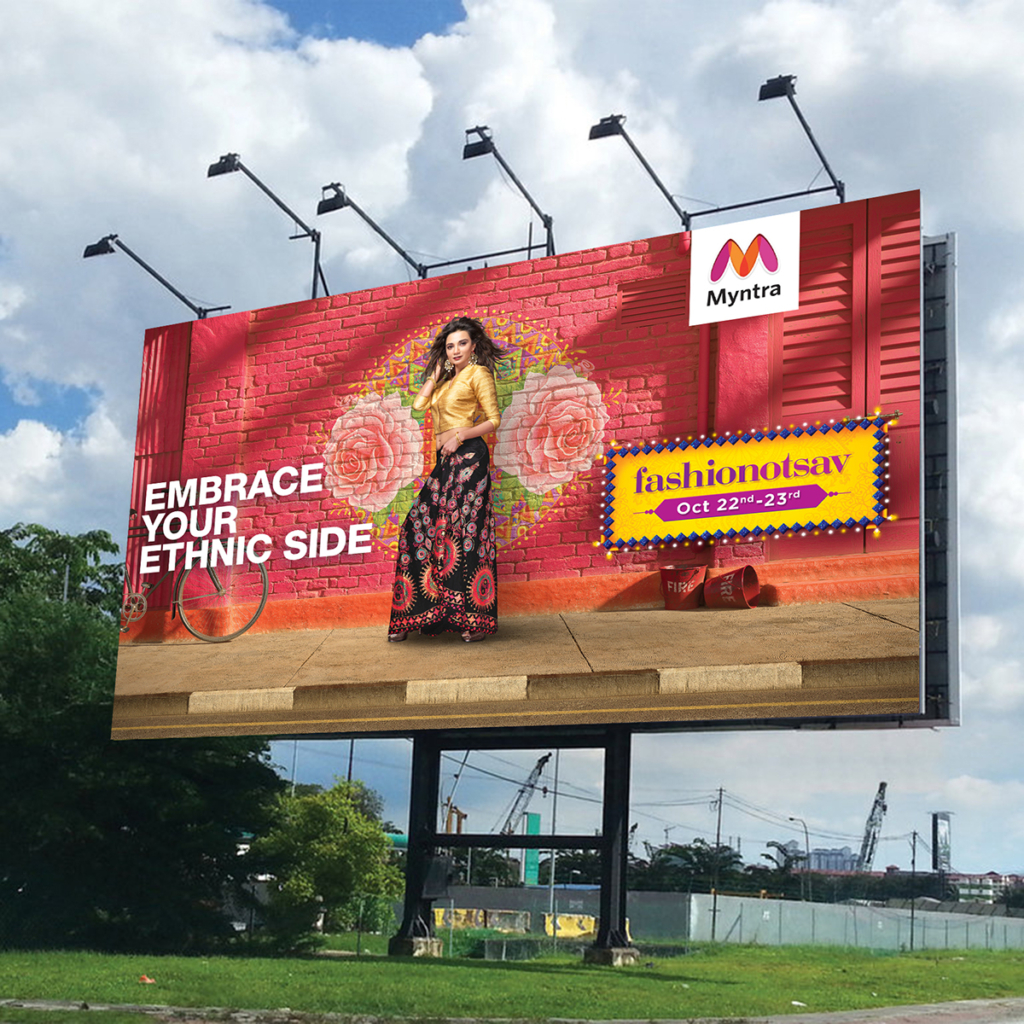
Image credit- Afaqs
Both businesses saw enormous success as a result of their marketing plans and ad operations. These businesses would still be unknown if they had not reached their target audiences at the correct time and through the right channels. Zomato and Myntra needed to avoid bombarding customers with frequent and unnecessary ads to provide an excellent customer experience. They were aware of the demographics and preferences of their audience. Both businesses achieved the ideal mix between client satisfaction and revenue generation. The organizations were able to make informed decisions due to their comprehensive insights.
The Future of Ad Ops in India
Ad operations teams will need to embrace newer platforms and follow the lead of younger demographics as the Indian advertising market continues to grow. Digital-out-of-home (DOOH) advertising tools are among the new technologies that enable marketers to reach audiences in public spaces with customized content. Moreover, it’s clear that ad operations are no longer only a tactical role. Ad operations teams are already becoming more strategic, leveraging technology to solve business challenges and playing a key role in revenue growth because of their close relationship to revenue. However since digital media is always changing, ad operations professionals should expect to face a number of new difficulties in the coming years.
- The volume of campaigns will keep growing at an exponential rate.
- The range of available ad formats will increase.
- Utilizing first-party data effectively will be essential—even more so than it is now.
- Changes in policy will be implemented on a worldwide, regional, and national scale.
- There will be more pressure on companies to maintain high margins while increasing revenue.
- Publishers will see that ad ops teams with a tech focus can directly affect revenue.
- Ad ops teams’ increased awareness of revenue workflows and data will help them move closer to the strategic side of the business.
Another important factor in digital marketing will be the development of technology. Fortunately, generative AI has made it simpler for ad operations teams to create more content in greater quantities intended for multiple channels. This technology can be used by ad operations specialists to test ad tech platforms, generate and evaluate audience segments, and produce content in a variety of formats. Ad operations teams can concentrate more on gathering information and using data-driven insights to guide marketing and revenue decisions as generative AI enhances automation.
Final Words
Ad Ops is increasingly playing a crucial role in the Indian advertising sector by enhancing efficiency, targeting, and campaign effectiveness. In this industry, automation and personalization must be carefully balanced. Ad operations will be essential in ensuring ad viewability and brand safety as the advertising landscape changes. Cheers to the growth of ad operations and their bright future in the Indian advertising industry.
Read More: Cricket’s Advertising Blitz: Boundaries Beyond the Game!
LG Ad Solutions and Affinity Solutions Redefine CTV Ad Targeting and Measurement
With novel closed-loop CTV targeting and measurement technologies, LG Ad Solutions and Affinity Solutions have formed a fresh relationship. While Affinity Solutions is the top provider of consumer purchasing information, LG Ad Solutions is a world leader in connected TV (CTV) and cross-screen advertising. The brand-new service, called LoopIQ, was specifically created to use purchase data to target the appropriate people in CTV settings while also assessing the effectiveness of campaigns at boosting consumer spending. The firms claim that the introduction of LoopIQ solutions is in response to growing calls for more precise targeting and concrete measuring techniques in the connected TV market.
Growth in CTV Advertising
Connected TV advertising gives ad tech stakeholders an admirable long-term opportunity by empowering brand advertisers to use data insights to improve ad targeting and campaign optimization. It is unique in that it combines the audience of conventional television with the accuracy and measurement of web advertising. Despite the fact that Connected TV currently only makes up a small portion of the programmatic market, CTV still receives more than $2 for every $5 spent on programmatic. CTV advertising has remained strong despite some collapse in the programmatic market in 2023, and analysts forecast that CTV will account for the majority of the market’s growth in the coming years.
Read More: Samsung Ads Partners with Brightline To Boost CTV Advertising
Insights on LoopIQ
The powerful solution brings together LG Ad Solutions’ Connected TV advertising infrastructure and Affinity’s data analytics know-how. The firms also states that they are dedicated to pushing the limits of what is feasible in the CTV ad space. Furthermore, they want to provide more value to advertisers while improving viewer experiences. The launch of LoopIQ is expected to change how marketers approach CTV advertising. It will also look to establish new standards for ROI in the market. LoopIQ will combine purchase information with already-available tools. These include Automatic Content Recognition (ACR). It complies with privacy regulations, to give brands access to more accurate targeting and measurement outcomes. Additionally, the solution ought to support accurate audience optimization of advertising expenditures.
Here’s what they said
Tony Marlow, Global Chief Marketing Officer of LG Ad Solutions said,
The partnership between LG Ad Solutions and Affinity to launch LoopIQ marks a significant evolution in the CTV advertising landscape. LoopIQ’s unique capability to effectively link purchase data with ad targeting and measurement is set to revolutionize the way brands reach and resonate with their audiences in ad-supported streaming environments.
Damian Garbaccio, Chief Business & Marketing Officer of Affinity added,
We are thrilled to join forces with LG Ad Solutions on this groundbreaking endeavor. LoopIQ is a testament to our joint vision of harnessing exclusive consumer purchase data to craft more meaningful outcomes and efficient advertising experiences.
Read More: Microsoft Advertising Enters the Video and CTV Advertising Realm
Shopify Audiences Expands Ad Targeting Capabilities with New Integrations
Shopify Audiences, Shopify’s ad tech integration offering revealed a new ad targeting capability. Additionally, it increased the number of its partners. Initially, Shopify Audiences debuted with just Google and Meta. Later on, Pinterest was included in the mix. Recently, Shopify Audiences announced new connections with three significant ad platforms, Snap, TikTok, and Criteo. The collaborations increase the effectiveness and reach of Shopify Plus merchants, enabling them to more precisely target customers. The platforms will be able to connect to Shopify utilizing their preferred ad network for modeling data.
Shopify audiences
Shopify Audiences was introduced last year with the goal of streamlining client acquisition and assisting retailers in raising their return on ad spend (ROAS). It now offers greater analytics and links to new ad channel partners, including Snap, Criteo, and TikTok, thanks to an updated version. It also has the best algorithms yet, which can cut customer acquisition costs by as much as 50%. The strong ad platform alliances enable Shopify Plus retailers to contact their target clients more extensively and affordably.
Benchmarking functionality for optimized ad performance measurement
With the help of Shopify Audiences’ benchmarking feature, retailers can assess how well their advertising campaigns are performing against those of other companies in a similar industry. The function also offers additional insights and makes it easier to make data-driven decisions. It enables businesses to improve the effectiveness of their advertising. The updated features add to a tool that is always being improved to increase consumer acquisition and return on advertising spend. For instance,
T-shirts created to order are available from a vendor. Despite the fact that they sell clothing, they are not high-end outfit designers. With Shopify Audiences’ new benchmarking feature, they can assess the success of their campaigns against those of other, comparable businesses, not only clothing stores. With a more apples-to-apples comparison, this offers more insightful information.
Read More: Roku-Shopify Revolutionize TV Ads By Enabling On-Screen Purchases
The Shopportunity
Shopify Audiences does not collect or offer user-level data. It can create unique audiences who could be interested in a certain product. This is thanks to Shopify’s data modeling hub, which is based on Shopify’s analysis of its merchant base. In comparison to other payment-based advertising products, Shopify Audiences offers less privacy exposure. Shopify is now at ease adding third-party programmatic thanks to Criteo.
The algorithm becomes more effective as more companies use Shopify Audiences and sign up for the platform, using particular insights from customers across participating shops. This in turn boosts output, creating a positive feedback loop. The success of Shopify Audiences is heavily dependent on this loop. Additionally, it’s stated that Shopify Audiences is a major factor in why merchants decide to upgrade to Plus, with many implementing it an average of one week after their upgrade.
Shopify Purpose
The Shopify Plus package, a more expensive membership level for their e-commerce platform, includes Shopify Audiences. Shopify doesn’t receive any CPM revenue. Furthermore, unlike retail media networks, it doesn’t receive a cut of revenues or a high CPM associated with such purchases. This implies that Audiences aren’t always a significant revenue generator. Instead, as it includes new merchants in the Plus category, it gains value. Increased sales from all merchants benefit Shopify, which receives a fee for processing payments. Shopify could easily enter the media category and tie its data to CPM if it wanted to increase its audience revenue. It is the only platform that Meta would consider using to replicate its sales attribution network for e-commerce sellers.
Read More: Criteo’s Commerce Max DSP Unites Retail Media with General Availability
Shopify Momentum
The products from Shopify work together to develop better services for retailers and give them a unified offering. Shopify Plus retailers can use their Shopify Credit cards to pay for their advertising costs while receiving cash back. The audience is a special advantage that only Shopify offers. It uses the combined strength of Shopify merchants to make it easier for them to efficiently attract new clients. Shopify makes investments in this area to help companies reach clients worldwide. Retailers could be reluctant to provide information that will be gathered and then used by other merchants, including potential rivals. They may view their involvement with Shopify Audiences as a means to connect with fresh potential clients.
Here’s what they said
Shopify’s VP of Advertising, David Wurtz said,
Shopify is at the forefront of commerce. Wherever there’s an opportunity to connect merchants and buyers, Shopify is there first. Since launching Shopify Audiences last year, our algorithms have only gotten smarter and more effective thanks to the collective power of our merchants. We’ve long said that commerce is not a zero-sum game. Together, the independent merchants on Shopify help each other win. A lot of the inventory on the open web is underappreciated and underpriced. With the addition of Criteo, Shopify can drive “a lot of volume” of ads to the web and improve customer acquisition costs for its merchants, just like the big social platforms have for particular brands or categories.
Rory Mitchell, Criteo’s GM of global growth added,
Aside from access to Shopify custom audiences, Criteo “can then show the power of our platform, which allows a Shopify merchant to think about things like onboarding their first-party data to our platform for retention or retargeting campaigns. It’s a “natural progression,” he added, from the modeled approach to Criteo’s shopper graph products, which do use onboarded first-party data. And we know how to get performance for these customers in a way that is really scalable across the open internet.
Ali Rana, Global Head of Revenue Partnerships for Snap commented,
We’re thrilled to team up with a commerce leader like Shopify to enable merchants to reach more high-intent shoppers on Snap.
Read More: New ‘Instacart for Shopify App’ Revolutionizes Merchant Advertising




